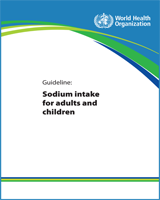Annex 8Summary of considerations for determining the strength of the recommendations
View in own window
| Quality of evidence: |
High-quality evidence that decreasing sodium is beneficial for blood pressure in adults. High-quality evidence that decreasing sodium has no harmful effect on blood lipids, catecholamine levels, renal function or any minor side effects (e.g. headache and dizziness) in adults. Moderate-quality evidence that reduced sodium is consistent with a benefit to renal function in adults. Because of the well-established relationship between blood pressure and cardiovascular disease outcomes, the evidence of an effect of sodium on blood pressure was also considered moderate-quality evidence that reduced sodium is beneficial for reducing risk of cardiovascular disease, stroke and coronary heart disease. Moderate-quality evidence that reduced sodium is beneficial for controlling blood pressure in children. Moderate-quality evidence that reduced sodium has no harmful effect on blood lipids, catecholamine levels or any minor side effects (e.g. headache and dizziness) in children. High and moderate-quality evidence that consuming <2 g sodium/ day compared with consuming ≥2 g sodium/day is beneficial for reducing blood pressure and risk of cardiovascular disease, stroke and coronary heart disease in adults. High-quality evidence that consuming <2 g sodium/day compared with consuming ≥2 g sodium/day has no effect on blood lipids or catecholamine levels; however, recognizing that these data come from a limited number of studies, directly testing the effect of <2 g sodium/day compared with consuming ≥2 g sodium/day on these outcomes.
|
|---|
| Values and preferences: |
This recommendation places a high value on reduction of blood pressure, cardiovascular disease, stroke, coronary heart disease and related NCDs. NCDs affect countries in all regions and all income levels, thus rendering interventions to reduce the burden of NCDs valuable in all contexts. Recognizing that some persons have taste preference for higher sodium foods. Recognizing that reformulation of processed foods would be necessary to provide consumers with choices of lower-sodium products that continue to be palatable to the consumer and marketable for producers.
|
|---|
| Trade-off between benefits and harm: |
High-quality evidence in adults and moderate-quality evidence in children of benefit of decreasing sodium intake on blood pressure. Blood pressure is a good proxy indicator for risk of cardiovascular disease, stroke and coronary heart disease outcomes. Though inconclusive, there was evidence from the meta-analyses of cohort studies measuring cardiovascular disease or coronary heart disease that reduced sodium has potential benefits. The cohort data supported a reduction in risk of stroke with decreased sodium intake. High-quality evidence in adults and moderate-quality evidence in children indicates no negative effect on blood lipids or catecholamine levels with decreased sodium intake for 4 weeks or more.
|
|---|
| Costs and feasibility: |
Cost–benefit analyses have consistently identified reduced sodium intake as one of the most cost-effective public health interventions available. In many countries, this recommendation will require: - –
the cooperation of the food industry to reduce sodium content in processed foods and to make reduced sodium products widely available and accessible, to provide consumer choice; - –
activities to raise consumer awareness; - –
improvements in food labelling.
Experience in some countries has demonstrated that reduction of sodium content of processed foods is feasible and achievable for food manufacturers working in close cooperation with government agencies, and that these efforts can result in marked reductions in sodium content of products without adverse consumer reaction. Additional strategies for the implementation of these recommendations will include public education, health promotion, and behavioural change. These strategies are even more important in contexts where most sodium intake comes from addition in the home.
|
|---|

